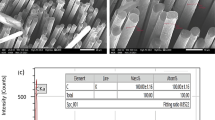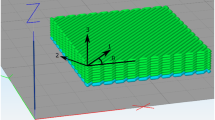Abstract
Mill scale (MS) strengthened acrylonitrile-butadiene-styrene (ABS) composite filaments were fabricated as an optional low-cost and sustainable feedstock material with enhanced strength using fused filament fabrication (FFF) technology. In the present study, the effects of the FFF printing parameters on the mechanical properties of the printed ABS/1.0 vol% MS composites were evaluated. Test specimens of the composite were fabricated at printing temperatures of 240–280 °C, printing speeds of 10–90 mm s−1, and infill densities of 25–100%. Tensile tests and Izod impact tests were conducted for the specimens printed under different printing conditions to examine their mechanical characteristics. Afterwards, macro- and microstructural observations of the fractured specimens were carried out. The average maximum stress and modulus of the printed specimens increased when the printing temperature was raised to 270 °C while decreasing the printing speed, with numerous air gaps and pores found in the cross-sectional microstructures after failure at low infill density. High surface roughness of the printed composites was observed by a 3D laser scanner when printing at high temperatures and speeds due to insufficient cooling. The printed composite microstructures were examined by X-ray micro-computed tomography (μCT), and showed homogeneously dense particle dispersion in the entire printed part. Representative volume element (RVE)-based modeling was carried out using real particle geometries from the μCT. RVE simulations predicted high local stress distributions around mill scale particles and air gaps in the printed samples.



















Similar content being viewed by others
Data availability
The raw/processed data required to reproduce these findings cannot be shared as the data also forms part of an ongoing study.
References
Buchanan C, Gardner L (2019) Metal 3D printing in construction: a review of methods, research, applications, opportunities and challenges. Eng Struct 180:332–348. https://doi.org/10.1016/j.engstruct.2018.11.045
Sama SR, Badamo T, Lynch P et al (2019) Novel sprue designs in metal casting via 3D sand-printing. Addit Manuf 25:563–578. https://doi.org/10.1016/j.addma.2018.12.009
Thompson MK, Moroni G, Vaneker T et al (2016) Design for additive manufacturing: trends, opportunities, considerations, and constraints. CIRP Annals 65:737–760. https://doi.org/10.1016/j.cirp.2016.05.004
Grand View Research (2021) Additive manufacturing market size, share & trends analysis report by component, by printer type, by technology, by software, by application, by vertical, by material, by region, and segment forecasts, 2022–2030. https://www.grandviewresearch.com/industry-analysis/additive-manufacturing-market#. Accessed 17 Oct 2023
Chartier T, Badev A (2013) Rapid prototyping of ceramics. In: Handbook of Advanced Ceramics: Materials, Applications, Processing, and Properties, 2nd edn, pp 489–524
Kumar R, Singh R, Ahuja I (2019) Joining of 3D printed dissimilar thermoplastics with consumable tool through friction stir spot welding: a case study. In: Encyclopedia of Renewable and Sustainable Materials, pp 1–5. https://doi.org/10.1016/B978-0-12-803581-8.11529-2
Mohamed O, Masood S, Bhowmik J (2022) Experimental and statistical modeling on surface roughness for FDM PC-ABS polymeric material using D-optimal design. In: Reference Module in Materials Science and Materials Engineering. https://doi.org/10.1016/B978-0-12-820352-1.00103-6
Tian X, Todoroki A, Liu T et al (2022) 3D printing of continuous fiber reinforced polymer composites: development, application, and prospective. Chinese Journal of Mechanical Engineering: Additive Manufacturing Frontiers 1:100016. https://doi.org/10.1016/j.cjmeam.2022.100016
Zhang H, Wu Y, Wang K et al (2020) Materials selection of 3D-printed continuous carbon fiber reinforced composites considering multiple criteria. Mater Des 196:109140. https://doi.org/10.1016/j.matdes.2020.109140
Aumnate C, Pongwisuthiruchte A, Pattananuwat P et al (2018) Fabrication of ABS/graphene oxide composite filament for fused filament fabrication (FFF) 3D printing. Adv Mater Sci Eng 2018:1–9. https://doi.org/10.1155/2018/2830437
Aqzna SS, Yeoh CK, Idris MS et al (2018) Effect of different filler content of ABS-zinc ferrite composites on mechanical, electrical and thermal conductivity by using 3D printing. J Vinyl Addit Technol 24:E217–E229. https://doi.org/10.1002/vnl.21640
Tungtrongpairoj J, Doungkeaw K, Thavornyutikarn B et al (2023) Mill scale strengthened ABS composite filaments for 3D printing technology. J Mater Sci 58:4165–4183. https://doi.org/10.1007/s10853-023-08274-0
Wu W, Ye W, Wu Z et al (2017) Influence of layer thickness, raster angle, deformation temperature and recovery temperature on the shape-memory effect of 3D-printed polylactic acid samples. Materials (Basel) 10. https://doi.org/10.3390/ma10080970
Niendorf K, Raeymaekers B (2021) Additive manufacturing of polymer matrix composite materials with aligned or organized filler material: a review. Adv Eng Mater 23:2001002. https://doi.org/10.1002/adem.202001002
Abeykoon C, Sri-Amphorn P, Fernando A (2020) Optimization of fused deposition modeling parameters for improved PLA and ABS 3D printed structures. Int J Lightweight Mater Manuf 3:284–297. https://doi.org/10.1016/j.ijlmm.2020.03.003
Dave HK, Davim JP (eds) (2021) Fused deposition modeling based 3D printing. Materials forming, machining and tribology. Springer, Cham, Switzerland
Wang P, Zou B, Ding S et al (2021) Effects of FDM-3D printing parameters on mechanical properties and microstructure of CF/PEEK and GF/PEEK. Chin J Aeronaut 34:236–246. https://doi.org/10.1016/j.cja.2020.05.040
Mihankhah P, Azdast T, Mohammadzadeh H et al (2023) Fused filament fabrication of biodegradable polylactic acid reinforced by nanoclay as a potential biomedical material. J Thermoplast Compos Mater 36:961–983. https://doi.org/10.1177/08927057211044185
Behzadnasab M, Yousefi A (2016) Effects of 3D printer nozzle head temperature on the physical and mechanical properties of PLA based product. 12th International Seminar on Polymer Science and Technology. Islamic Azad University. Tehran, Iran
Ouazzani K, El Jai M, Akhrif I et al (2023) An experimental study of FDM parameter effects on ABS surface quality: roughness analysis. Int J Adv Manuf Technol 127:151–178. https://doi.org/10.1007/s00170-023-11435-9
Badogu K, Kumar R, Kumar R (2023) Investigations on hardness and surface roughness of 3D printed ABS-ZrO2 composite structures for post processing applications. Materials Today: Proceedings. https://doi.org/10.1016/j.matpr.2023.11.032
Zheng J, Dong E, Kang J et al (2021) Effects of raster angle and material components on mechanical properties of polyether-ether-ketone/calcium silicate scaffolds. Polymers (Basel) 13. https://doi.org/10.3390/polym13152547
Srinivasan Ganesh Iyer S, Keles O (2022) Effect of raster angle on mechanical properties of 3D printed short carbon fiber reinforced acrylonitrile butadiene styrene. Compos Commun 32:101163. https://doi.org/10.1016/j.coco.2022.101163
Algarni M (2021) The influence of raster angle and moisture content on the mechanical properties of PLA parts produced by fused deposition modeling. Polymers (Basel) 13. https://doi.org/10.3390/polym13020237
Wang X, Zhao L, Fuh JYH et al (2019) Effect of porosity on mechanical properties of 3D printed polymers: experiments and micromechanical modeling based on X-ray computed tomography analysis. Polymers (Basel) 11. https://doi.org/10.3390/polym11071154
Zhang X, Chen L, Mulholland T et al (2019) Effects of raster angle on the mechanical properties of PLA and Al/PLA composite part produced by fused deposition modeling. Polym Adv Technol 30:2122–2135. https://doi.org/10.1002/pat.4645
Hasanzadeh R, Mihankhah P, Azdast T et al (2023) Optimization of process parameters of fused filament fabrication of polylactic acid composites reinforced by aluminum using Taguchi approach. Metals 13:1013. https://doi.org/10.3390/met13061013
Hasanzadeh R, Mihankhah P, Azdast T et al (2023) Biocompatible tissue-engineered scaffold polymers for 3D printing and its application for 4D printing. Chem Eng J 476:146616. https://doi.org/10.1016/j.cej.2023.146616
Khosravani MR, Anders D, Reinicke T (2023) Effects of post-processing on the fracture behavior of surface-treated 3D-printed parts. CIRP J Manuf Sci Technol 46:148–156. https://doi.org/10.1016/j.cirpj.2023.08.006
Hanon M, Zsidai L (2023) Investigation on the accuracy, hardness, and surface roughness of photopolymerization 3D printing technique objects. AIP Conf Proc 2607:120003-1–120003-5. https://doi.org/10.1063/5.0135763
Çakan BG (2021) Effects of raster angle on tensile and surface roughness properties of various FDM filaments. J Mech Sci Technol 35:3347–3353. https://doi.org/10.1007/s12206-021-0708-8
Ning F, Cong W, Qiu J et al (2015) Additive manufacturing of carbon fiber reinforced thermoplastic composites using fused deposition modeling. Compos Part B Eng 80:369–378. https://doi.org/10.1016/j.compositesb.2015.06.013
Li N, Li Y, Liu S (2016) Rapid prototyping of continuous carbon fiber reinforced polylactic acid composites by 3D printing. J Mater Process Technol 238:218–225. https://doi.org/10.1016/j.jmatprotec.2016.07.025
Hasanzadeh R, Mihankhah P, Azdast T et al (2023) Process-property relationship in polylactic acid composites reinforced by iron microparticles and 3D printed by fused filament fabrication. Polym Eng Sci. https://doi.org/10.1002/pen.26556
Rasouli A, Azdast T, Mohammadzadeh H et al (2022) Morphological properties and mechanical performance of polylactic acid scaffolds fabricated by a novel fused filament fabrication/gas foaming coupled method. Int J Adv Manuf Technol 119:7463–7474. https://doi.org/10.1007/s00170-022-08743-x
Azdast T, Hasanzadeh R (2021) Polylactide scaffold fabrication using a novel combination technique of fused deposition modeling and batch foaming: dimensional accuracy and structural properties. Int J Adv Manuf Technol 114:1309–1321. https://doi.org/10.1007/s00170-021-06915-9
Shah SP, Maiarù M (2021) Effect of manufacturing on the transverse response of polymer matrix composites. Polymers (Basel) 13. https://doi.org/10.3390/polym13152491
Ferretti P, Santi GM, Leon-Cardenas C et al (2021) Representative volume element (RVE) analysis for mechanical characterization of fused deposition modeled components. Polymers (Basel) 13. https://doi.org/10.3390/polym13203555
Aqzna SS, Yeoh CK, Idris M et al (2019) The effect of different raster orientations of ABS - zinc ferrite composites on mechanical, electrical and thermal conductivity properties via 3D printer. Mater Today: Proc 16:1804–1808. https://doi.org/10.1016/j.matpr.2019.06.054
Sa’ude N, Ibrahim M, MHI I (2013) Mechanical properties of highly filled iron-ABS composites in injection molding for FDM wire filament. MSF 773-774:448–453. https://doi.org/10.4028/www.scientific.net/MSF.773-774.448
Mohamed OA, Masood SH, Bhowmik JL (2015) Optimization of fused deposition modeling process parameters: a review of current research and future prospects. Adv Manuf 3:42–53. https://doi.org/10.1007/s40436-014-0097-7
Joanna Izdebska-Podsiadły (2022) Polymers for 3D printing: Methods, Properties and Characteristics (Plastics Design Library). William Andrew Publishing
Oksman K, Skrifvars M, Selin J-F (2003) Natural fibres as reinforcement in polylactic acid (PLA) composites. Compos Sci Technol 63:1317–1324. https://doi.org/10.1016/S0266-3538(03)00103-9
Waheed S, Cabot JM, Smejkal P et al (2019) Three-dimensional printing of abrasive, hard, and thermally conductive synthetic microdiamond-polymer composite using low-cost fused deposition modeling printer. ACS Appl Mater Interfaces 11:4353–4363. https://doi.org/10.1021/acsami.8b18232
dos Santos WN, de Sousa JA, Gregorio R (2013) Thermal conductivity behaviour of polymers around glass transition and crystalline melting temperatures. Polym Test 32:987–994. https://doi.org/10.1016/j.polymertesting.2013.05.007
Bleck W (2016) Materials science of steel-textbook for students at RWTH. IEHK publishing, Aachen
Goh GD, Yap YL, Agarwala S et al (2019) Recent progress in additive manufacturing of fiber reinforced polymer composite. Adv Mater Technol 4:1800271. https://doi.org/10.1002/admt.201800271
Gebisa AW, Lemu HG (2018) Investigating effects of fused-deposition modeling (FDM) processing parameters on flexural properties of ULTEM 9085 using designed experiment. Materials (Basel) 11. https://doi.org/10.3390/ma11040500
Chicot D, Mendoza J, Zaoui A et al (2011) Mechanical properties of magnetite (Fe3O4), hematite (α-Fe2O3) and goethite (α-FeO·OH) by instrumented indentation and molecular dynamics analysis. Mater Chem Phys 129:862–870. https://doi.org/10.1016/j.matchemphys.2011.05.056
Liu Q, Qi F, Wang Q et al (2018) The influence of particles size and its distribution on the degree of stress concentration in particulate reinforced metal matrix composites. Mater Sci Eng A 731:351–359. https://doi.org/10.1016/j.msea.2018.06.067
Chawla N, Chawla KK (2006) Microstructure-based modeling of the deformation behavior of particle reinforced metal matrix composites. J Mater Sci 41:913–925. https://doi.org/10.1007/s10853-006-6572-1
Acknowledgements
This research study was supported by King Mongkut’s University of Technology North Bangkok under contract no. KMUTNB-67-KNOW-05. The authors acknowledge the National Metal and Materials Technology Center (MTEC), Thailand, for providing facilities through the Biofunctional Materials and Devices Research Unit. We would like to thank Mr. Phachai Kungwankrai and Mr. Suksan Muengto for technical assistance in filament extrusion and 3D printing.
Author information
Authors and Affiliations
Contributions
Jennarong Tungtrongpairoj: conceptualization, experimental design, methodology, software, data curation, writing—original draft, visualization, investigation, software, validation, funding acquisition. Korbkaroon Doungkeaw: methodology, carrying out measurements and calculation. Boonlom Thavornyutikarn: experimental design, methodology, writing—review and editing. Peeraphat Suttipong: software, simulation. Vitoon Uthaisangsuk: writing—review and editing, investigation, supervision.
Corresponding author
Ethics declarations
Competing interests
The authors declare no competing interests.
Additional information
Publisher’s Note
Springer Nature remains neutral with regard to jurisdictional claims in published maps and institutional affiliations.
Rights and permissions
Springer Nature or its licensor (e.g. a society or other partner) holds exclusive rights to this article under a publishing agreement with the author(s) or other rightsholder(s); author self-archiving of the accepted manuscript version of this article is solely governed by the terms of such publishing agreement and applicable law.
About this article
Cite this article
Tungtrongpairoj, J., Doungkeaw, K., Thavornyutikarn, B. et al. Processing and modeling of 3D-printed mill scale strengthened acrylonitrile butadiene styrene composites. Int J Adv Manuf Technol 131, 1567–1586 (2024). https://doi.org/10.1007/s00170-024-13037-5
Received:
Accepted:
Published:
Issue Date:
DOI: https://doi.org/10.1007/s00170-024-13037-5




